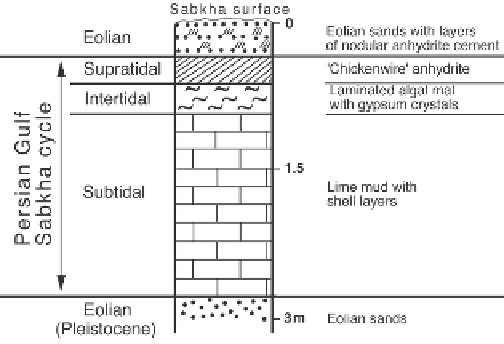Geology Reference
In-Depth Information
Plate 125 Standard Microfacies Types: SMF 23, SMF 24 and SMF 25
The plate displays two SMF Types distinguished by Wilson (1975) and the new SMF Type 25 characterizing
carbonate-evaporite transitional environments.
SMF 23. Non-laminated homogeneous micrite and microsparite without fossils
Criteria:
Unfossiliferous lime mudstone or fine-grained dolomicrite, sometimes with authigenic evaporite
minerals.
Occurrence:
Tidal flats (FZ 8) and arid evaporitic coasts (FZ 9A). Deposited in saline or evaporative
environments, e.g. in tidal ponds.
Remarks
: Note that micrites without fossils or other grains may also occur in
anoxic deep basins (FZ 1B), and that the 'lack' of fossils can only be a sampling effect.
SMF 24. Lithoclastic floatstones, rudstones and breccias
Criteria:
Coarse, up to several centimeter-sized angular carbonate lithoclasts. Elongated micrite clasts are
abundant, often edgewise arranged, and sometimes cross-bedded, forming an intraformational breccia.
Occur-
rence
: Platform interior (FZ 8). Lag deposits in tidal channels and on tidal flats.
SMF 25. Laminated evaporite-carbonate mudstone
Criteria:
Alternation of fine-crystalline carbonate (limestone, dolomite) which might be microbially induced,
and diagenetically deformed layers with evaporite crystals (gypsum).
Occurrence:
Upper intertidal to supratidal
sabkha facies (FZ 9A) in arid and semiarid coastal plains and evaporitic lacustrine basins.
1
SMF 23.
Non-laminated unfossiliferous mudstone
. Irregularly distributed voids result from the replacement of evaporite
minerals by calcite. FZ 9A. Middle Triassic: Northern Calcareous Alps, Austria.
2
SMF 23.
Non-laminated unfossiliferous dolomite mudstone.
Note the calcitized anhydrite rosettes within the fine-grained
idiotopic dolomite matrix. The micrite matrix corresponds to type 1 distinguished in Fig. 4.1, and is probably of physico-
chemical origin, as indicated by the very fine crystal size, the evaporite minerals, and the complete lack of fossils. Su-
pratidal environment. FZ 9A. Late Tertiary (Nullipore Formation, Miocene): Subsurface, Gulf of Suez, Egypt.
3
SMF 24.
Coarse lithoclastic rudstone-floatstone.
Imbricated flat pebble conglomerate consisting of partially dolomitized,
laminated 'algal' clasts (AC; algal mat chips) and exhibiting desiccation cracks (DC). Note the stylolitic joints of the
pebbles, indicating compaction and consolidation of the sediment prior to erosion and redeposition. The matrix is formed
by skeletal grains and neomorphic sparite. The conglomerate has been interpreted as storm sediment deposited within
tidal flat areas (FZ 8). Late Triassic (Calcare di Zu, Rhaetian): Denti della Vecchia, Lombardian Basin, northern Italy.
4
SMF 25.
Laminated evaporitic lime mudstone
composed of alternating layers of organic-rich calcimudstone (M), and
evaporitic layers (E) with tiny gypsum crystals. Some layers show early diagenetic entherolitic folds characterized by
antiform buckles. Note the deformation of folded and non-folded layers by the growth of large gypsum crystals (arrows).
The sample comes from the deep evaporitic part of a lacustrine basin. Early Tertiary (Eocene): Mormoiron Basin, France.
-> 3: Lakew 1990
Fig. 14.26.
SMF 25
is a characteristic of
sabkha facies
originally described from the Abu Dhabi coast on the
Arabian Gulf. Sabkha is an Arabian word for a salt flat
found near sand dunes. The sabkha cycles start with
subtidal shelly lime mud and muddy skeletal sands
commonly deposited in a lagoonal environment,
overlain by intertidal laminated sediments characterized
by algal/microbial mats containing gypsum. The
supratidal part of the cycle consists of anhydrite layers
whose nodules display a 'chickenwire' texture as the
result of displacive growth. The ancient counterpart of
this cycle is represented by subtidal fine-grained
dolomites or lime mudstones with rare fossils (mudstones,
sparse wackestones), followed by intertidal layered
dolomicrites or micritic limestones exhibiting parallel
and/or irregular, wavy laminations, and sometimes vanished evaporites. The supratidal sabkha facies can be recorded by
anhydrite beds. See Warren and Kendall(1985) for a review of sabkha criteria. Modified from Achauer (1982).

